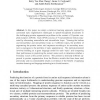Free Online Productivity Tools
i2Speak
i2Symbol
i2OCR
iTex2Img
iWeb2Print
iWeb2Shot
i2Type
iPdf2Split
iPdf2Merge
i2Bopomofo
i2Arabic
i2Style
i2Image
i2PDF
iLatex2Rtf
Sci2ools
ISMIS
2005
Springer
2005
Springer
A Machine Text-Inspired Machine Learning Approach for Identification of Transmembrane Helix Boundaries
In this paper, we adapt a statistical learning approach, inspired by automated topic segmentation techniques in speech-recognized documents to the challenging protein segmentation problem in the context of G-protein coupled receptors (GPCR). Each GPCR consists of 7 transmembrane helices separated by alternating extracellular and intracellular loops. Viewing the helices and extracellular and intracellular loops as 3 different topics, the problem of segmenting the protein amino acid sequence according to its secondary structure is analogous to the problem of topic segmentation. The method presented involves building an n-gram language model for each ‘topic’ and comparing their performance in predicting the current amino acid, to determine whether a boundary occurs at the current position. This presents a distinctly different approach to protein segmentation from the Markov models that have been used previously and its commendable results is evidence of the benefit of applying machine...
| Added | 27 Jun 2010 |
| Updated | 27 Jun 2010 |
| Type | Conference |
| Year | 2005 |
| Where | ISMIS |
| Authors | Betty Yee Man Cheng, Jaime G. Carbonell, Judith Klein-Seetharaman |
Comments (0)

